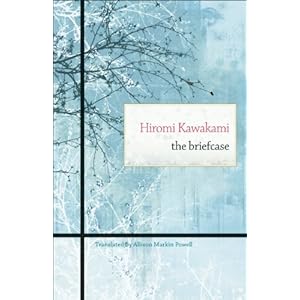A novel I've been very much looking forward to is Hiromi Kawakami's second appearance into English translation, after greatly enjoying the poeticism of Manazuru, the prose of The Briefcase has again a subtly understated simplicity to it that enables the reader to find themselves almost unawarely placed into the intricacies of the relationship between, Harutsuna Matsumoto, the ageing retired teacher, and Tsukiko Omachi, one of his former students who is now a woman facing middle age. The story is presented episodically, beginning with a chance meeting between the two again when they order exactly the same dish in a bar they both are eating in, the novel is presented through the perspective of Tsukiko, as the two become reacquainted the narrative begins to reveal episodes from her past, although a woman who has far from lived a sheltered life, we get the impression that she still lives in the same neighbourhood that she went to school in, re-meeting sensei, as Matsumoto is referred to by her throughout the novel, has provoked in her the realization that up til now she had been living a slightly oblivious existence, the world begins to appear in a new perspective.
After a few more meetings Tsukiko is invited to sensei's house, and discovers a collection of ceramic teapots from the boxed lunches that he and his wife bought from railway stations on their travels, background details of sensei's life aren't expanded upon greatly which adds a slightly enigmatic quality to him, although we learn that sensei's slightly bohemian wife passed away after leaving him. The little snippets of information about his characteristics we know are given to us through Tsukiko's observations, his dislike of having someone else pour his drink out for him, and throughout a reading of the novel the question of the contents of sensei's briefcase hovers at the peripheries of our thoughts. Some of their meetings are pre-arranged and some occur by coincidence, as the relationship develops, it's nature is enigmatic, Tsukiko's growing attachment to sensei becomes apparent in her narrative, an episode when in their favourite bar a drunk begins to ask how many times a week they slept together, begins to provoke the reader into questioning the nature of the relationship. Following the two's outings together sees them go on a market excursion, Kawakami's narrative captures Tsukiko's growing sense that the relationship is slightly absurd when she finds herself asking what is she doing? when she finds herself halfway up a mountain on a mushroom hunting trip with sensei and Satoru, the owner of their favourite bar, the novel is full of fantastic descriptions of Japanese dishes that makes you want to eat and drink while reading.
On another meeting she goes with sensei to a cherry blossom viewing party held at their old school, old teachers and old pupils gather for the party, Tsukiko meets Kojima, a fellow student who has since divorced his wife, the pair leave the party early and Kojima asks Tsukiko for more dates, but she finds that she's not attracted to him. Meeting with Kojima seems to tap into a whole wreath of nostalgic memories for the pair, although never does Tsukiko admit to ever having had a crush on sensei when she was at school, these passages see Tsukiko acknowledging the passing of time and the tide of it washing her up on an unfamiliar shore, reminiscing and being with Kojima she observes, 'it seemed like we had ended up within a time that didn't exist anymore'. Tsukiko is a fascinating character study, there is ample room to discuss her psychology at length, it could be said that the reason she develops an attachment to sensei is that she sometimes appears to be in a fragile emotional state at finding herself in an onset of spiritual dilemma in the face of approaching her middle age, but in Kawakami's prose the story can also be read with all the innocence of being a simple love story, although albeit being a slightly unconventional one being one that spans the generation gap, but this is the truer path of love. If this were a movie there are moments where it could be seen that Tsukiko is caught speaking directly into the camera, the narrative speaks out to us and sees Tsukiko ask the same questions the reader will find themselves asking, the answer perhaps lies in reading this fine translation.
The Briefcase/Sensei no kaban is translated by Allison Markin Powell and published by Counterpoint Press, the novel was awarded the Tanizaki Prize in 2001. The first chapter of The Briefcase, (The Moon and the Batteries), is available to read as a sampler at Granta's online site.

